Exploring Equality and Diversity: Attitudes Towards Women in Workplace
VerifiedAdded on 2022/10/15
|18
|4358
|14
Report
AI Summary
This report, prepared for the UGB350 course, analyzes the attitudes towards women in the workplace, addressing the challenges of discrimination, harassment, and unconscious bias. The report includes a secondary data analysis comparing local and global data on gender inequality, highlighting existing regulations and their impact. It examines challenges such as unequal pay, gender bias, and sexual harassment, along with the impact of these issues on women's mental and physical health. The report also proposes an educational toolkit designed to raise awareness, reduce bias, and promote gender equality within organizations, incorporating indicators, checklists, and training programs. Furthermore, it provides a literature review and reflection to overcome the unconscious bias with recommendations and concludes with suggestions for creating a more inclusive and equitable workplace.
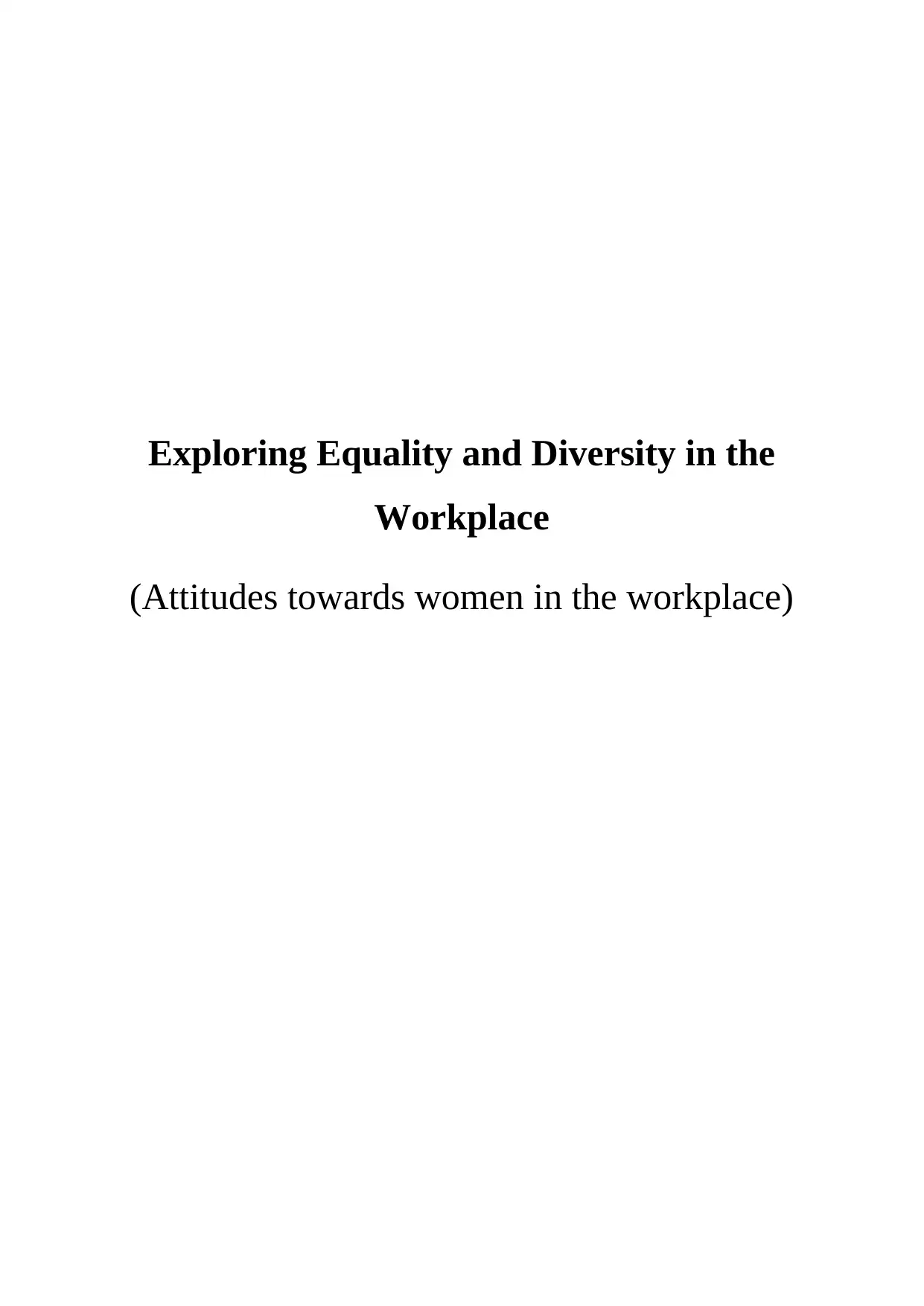
Exploring Equality and Diversity in the
Workplace
(Attitudes towards women in the workplace)
Workplace
(Attitudes towards women in the workplace)
Paraphrase This Document
Need a fresh take? Get an instant paraphrase of this document with our AI Paraphraser
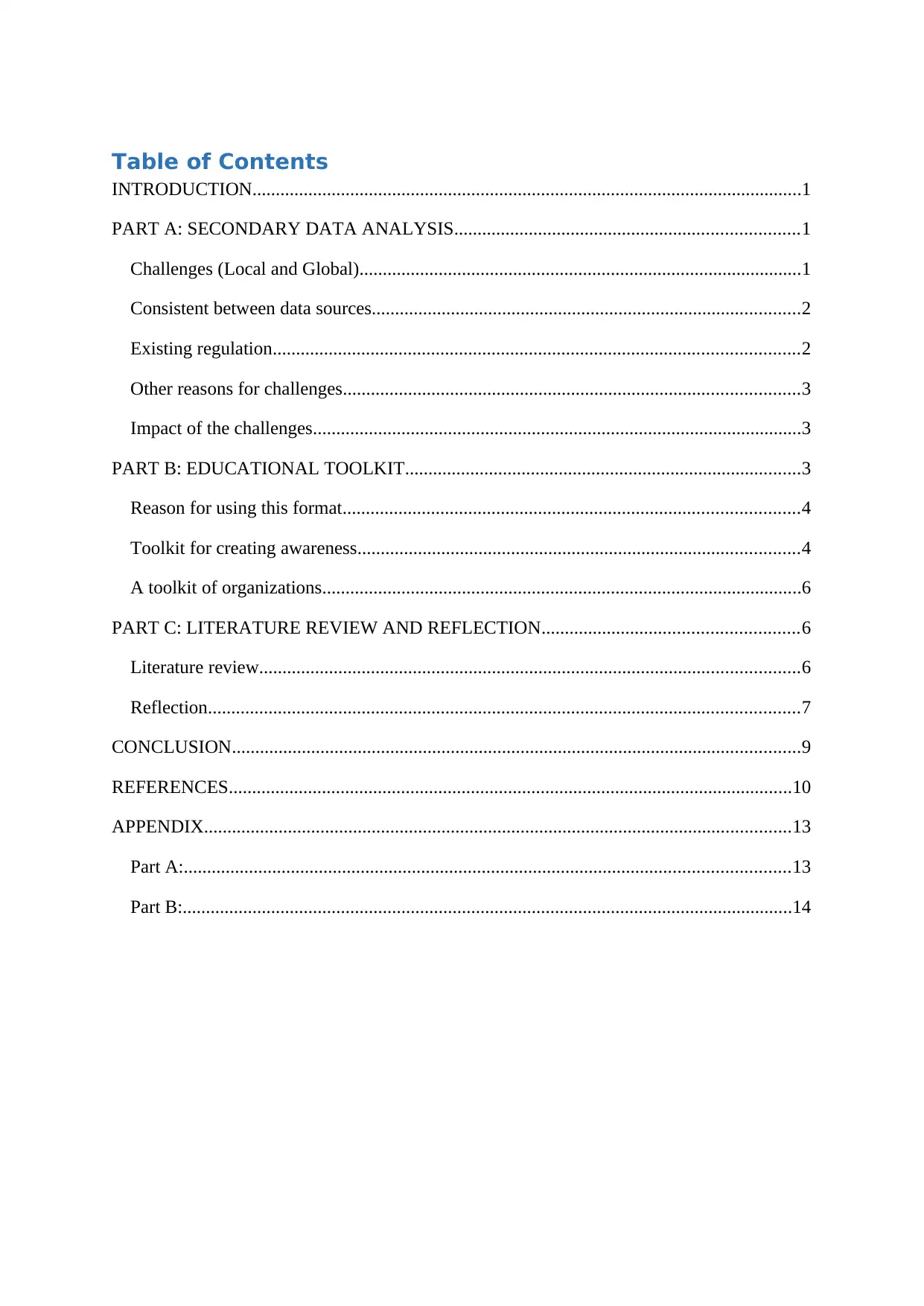
Table of Contents
INTRODUCTION......................................................................................................................1
PART A: SECONDARY DATA ANALYSIS..........................................................................1
Challenges (Local and Global)...............................................................................................1
Consistent between data sources............................................................................................2
Existing regulation.................................................................................................................2
Other reasons for challenges..................................................................................................3
Impact of the challenges.........................................................................................................3
PART B: EDUCATIONAL TOOLKIT.....................................................................................3
Reason for using this format..................................................................................................4
Toolkit for creating awareness...............................................................................................4
A toolkit of organizations.......................................................................................................6
PART C: LITERATURE REVIEW AND REFLECTION.......................................................6
Literature review....................................................................................................................6
Reflection...............................................................................................................................7
CONCLUSION..........................................................................................................................9
REFERENCES.........................................................................................................................10
APPENDIX..............................................................................................................................13
Part A:..................................................................................................................................13
Part B:...................................................................................................................................14
INTRODUCTION......................................................................................................................1
PART A: SECONDARY DATA ANALYSIS..........................................................................1
Challenges (Local and Global)...............................................................................................1
Consistent between data sources............................................................................................2
Existing regulation.................................................................................................................2
Other reasons for challenges..................................................................................................3
Impact of the challenges.........................................................................................................3
PART B: EDUCATIONAL TOOLKIT.....................................................................................3
Reason for using this format..................................................................................................4
Toolkit for creating awareness...............................................................................................4
A toolkit of organizations.......................................................................................................6
PART C: LITERATURE REVIEW AND REFLECTION.......................................................6
Literature review....................................................................................................................6
Reflection...............................................................................................................................7
CONCLUSION..........................................................................................................................9
REFERENCES.........................................................................................................................10
APPENDIX..............................................................................................................................13
Part A:..................................................................................................................................13
Part B:...................................................................................................................................14
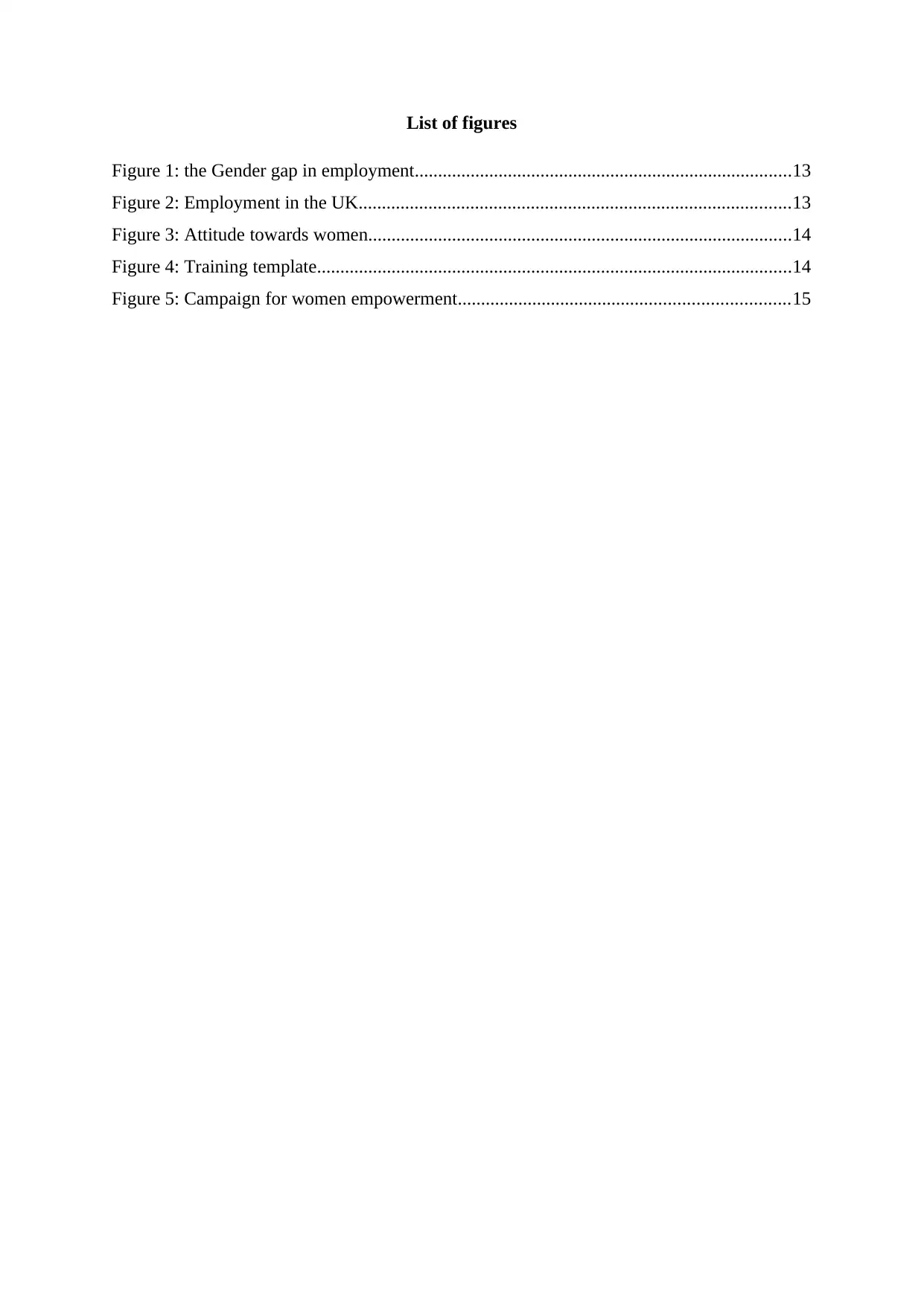
List of figures
Figure 1: the Gender gap in employment.................................................................................13
Figure 2: Employment in the UK.............................................................................................13
Figure 3: Attitude towards women...........................................................................................14
Figure 4: Training template......................................................................................................14
Figure 5: Campaign for women empowerment.......................................................................15
Figure 1: the Gender gap in employment.................................................................................13
Figure 2: Employment in the UK.............................................................................................13
Figure 3: Attitude towards women...........................................................................................14
Figure 4: Training template......................................................................................................14
Figure 5: Campaign for women empowerment.......................................................................15
⊘ This is a preview!⊘
Do you want full access?
Subscribe today to unlock all pages.

Trusted by 1+ million students worldwide
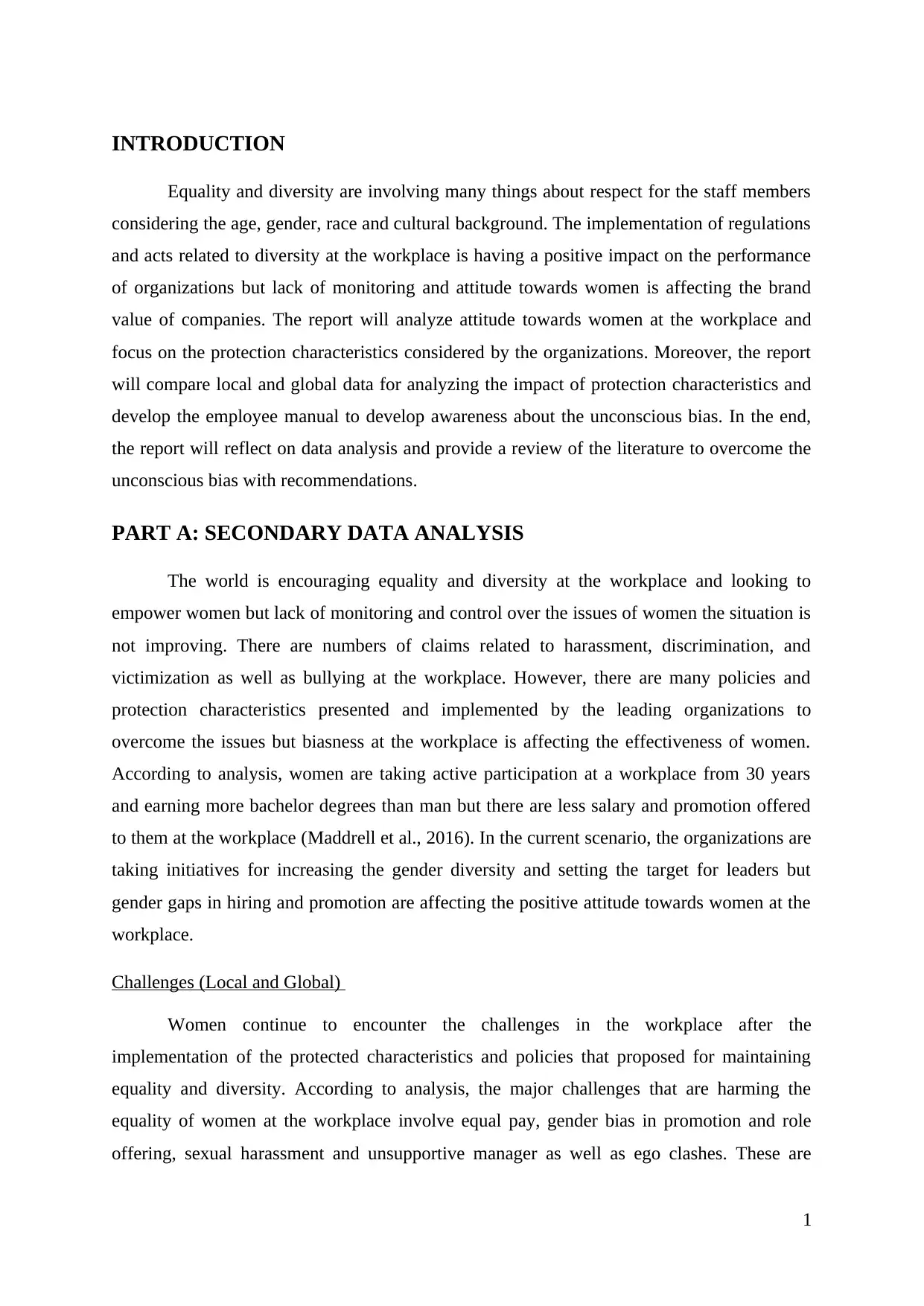
INTRODUCTION
Equality and diversity are involving many things about respect for the staff members
considering the age, gender, race and cultural background. The implementation of regulations
and acts related to diversity at the workplace is having a positive impact on the performance
of organizations but lack of monitoring and attitude towards women is affecting the brand
value of companies. The report will analyze attitude towards women at the workplace and
focus on the protection characteristics considered by the organizations. Moreover, the report
will compare local and global data for analyzing the impact of protection characteristics and
develop the employee manual to develop awareness about the unconscious bias. In the end,
the report will reflect on data analysis and provide a review of the literature to overcome the
unconscious bias with recommendations.
PART A: SECONDARY DATA ANALYSIS
The world is encouraging equality and diversity at the workplace and looking to
empower women but lack of monitoring and control over the issues of women the situation is
not improving. There are numbers of claims related to harassment, discrimination, and
victimization as well as bullying at the workplace. However, there are many policies and
protection characteristics presented and implemented by the leading organizations to
overcome the issues but biasness at the workplace is affecting the effectiveness of women.
According to analysis, women are taking active participation at a workplace from 30 years
and earning more bachelor degrees than man but there are less salary and promotion offered
to them at the workplace (Maddrell et al., 2016). In the current scenario, the organizations are
taking initiatives for increasing the gender diversity and setting the target for leaders but
gender gaps in hiring and promotion are affecting the positive attitude towards women at the
workplace.
Challenges (Local and Global)
Women continue to encounter the challenges in the workplace after the
implementation of the protected characteristics and policies that proposed for maintaining
equality and diversity. According to analysis, the major challenges that are harming the
equality of women at the workplace involve equal pay, gender bias in promotion and role
offering, sexual harassment and unsupportive manager as well as ego clashes. These are
1
Equality and diversity are involving many things about respect for the staff members
considering the age, gender, race and cultural background. The implementation of regulations
and acts related to diversity at the workplace is having a positive impact on the performance
of organizations but lack of monitoring and attitude towards women is affecting the brand
value of companies. The report will analyze attitude towards women at the workplace and
focus on the protection characteristics considered by the organizations. Moreover, the report
will compare local and global data for analyzing the impact of protection characteristics and
develop the employee manual to develop awareness about the unconscious bias. In the end,
the report will reflect on data analysis and provide a review of the literature to overcome the
unconscious bias with recommendations.
PART A: SECONDARY DATA ANALYSIS
The world is encouraging equality and diversity at the workplace and looking to
empower women but lack of monitoring and control over the issues of women the situation is
not improving. There are numbers of claims related to harassment, discrimination, and
victimization as well as bullying at the workplace. However, there are many policies and
protection characteristics presented and implemented by the leading organizations to
overcome the issues but biasness at the workplace is affecting the effectiveness of women.
According to analysis, women are taking active participation at a workplace from 30 years
and earning more bachelor degrees than man but there are less salary and promotion offered
to them at the workplace (Maddrell et al., 2016). In the current scenario, the organizations are
taking initiatives for increasing the gender diversity and setting the target for leaders but
gender gaps in hiring and promotion are affecting the positive attitude towards women at the
workplace.
Challenges (Local and Global)
Women continue to encounter the challenges in the workplace after the
implementation of the protected characteristics and policies that proposed for maintaining
equality and diversity. According to analysis, the major challenges that are harming the
equality of women at the workplace involve equal pay, gender bias in promotion and role
offering, sexual harassment and unsupportive manager as well as ego clashes. These are
1
Paraphrase This Document
Need a fresh take? Get an instant paraphrase of this document with our AI Paraphraser
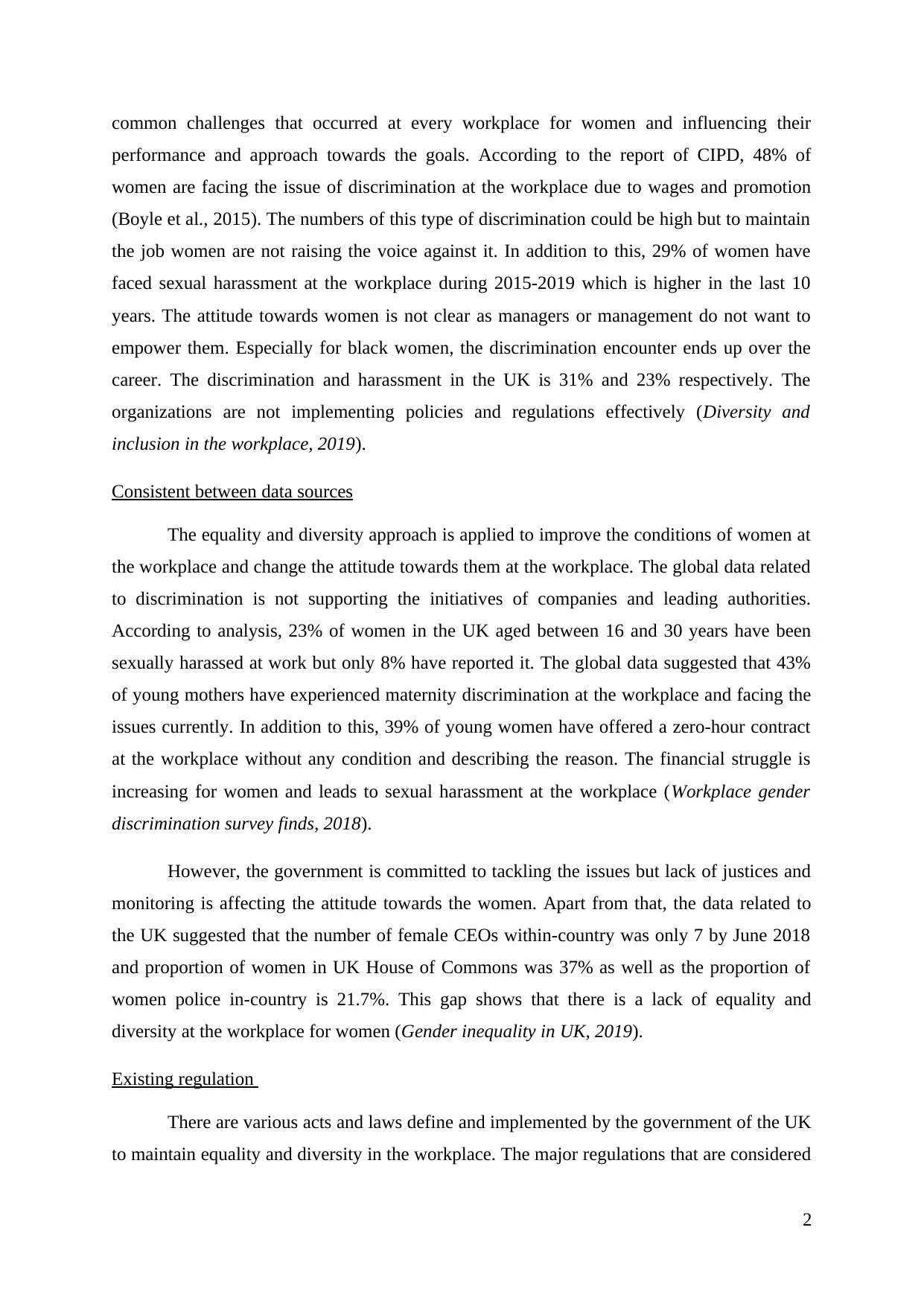
common challenges that occurred at every workplace for women and influencing their
performance and approach towards the goals. According to the report of CIPD, 48% of
women are facing the issue of discrimination at the workplace due to wages and promotion
(Boyle et al., 2015). The numbers of this type of discrimination could be high but to maintain
the job women are not raising the voice against it. In addition to this, 29% of women have
faced sexual harassment at the workplace during 2015-2019 which is higher in the last 10
years. The attitude towards women is not clear as managers or management do not want to
empower them. Especially for black women, the discrimination encounter ends up over the
career. The discrimination and harassment in the UK is 31% and 23% respectively. The
organizations are not implementing policies and regulations effectively (Diversity and
inclusion in the workplace, 2019).
Consistent between data sources
The equality and diversity approach is applied to improve the conditions of women at
the workplace and change the attitude towards them at the workplace. The global data related
to discrimination is not supporting the initiatives of companies and leading authorities.
According to analysis, 23% of women in the UK aged between 16 and 30 years have been
sexually harassed at work but only 8% have reported it. The global data suggested that 43%
of young mothers have experienced maternity discrimination at the workplace and facing the
issues currently. In addition to this, 39% of young women have offered a zero-hour contract
at the workplace without any condition and describing the reason. The financial struggle is
increasing for women and leads to sexual harassment at the workplace (Workplace gender
discrimination survey finds, 2018).
However, the government is committed to tackling the issues but lack of justices and
monitoring is affecting the attitude towards the women. Apart from that, the data related to
the UK suggested that the number of female CEOs within-country was only 7 by June 2018
and proportion of women in UK House of Commons was 37% as well as the proportion of
women police in-country is 21.7%. This gap shows that there is a lack of equality and
diversity at the workplace for women (Gender inequality in UK, 2019).
Existing regulation
There are various acts and laws define and implemented by the government of the UK
to maintain equality and diversity in the workplace. The major regulations that are considered
2
performance and approach towards the goals. According to the report of CIPD, 48% of
women are facing the issue of discrimination at the workplace due to wages and promotion
(Boyle et al., 2015). The numbers of this type of discrimination could be high but to maintain
the job women are not raising the voice against it. In addition to this, 29% of women have
faced sexual harassment at the workplace during 2015-2019 which is higher in the last 10
years. The attitude towards women is not clear as managers or management do not want to
empower them. Especially for black women, the discrimination encounter ends up over the
career. The discrimination and harassment in the UK is 31% and 23% respectively. The
organizations are not implementing policies and regulations effectively (Diversity and
inclusion in the workplace, 2019).
Consistent between data sources
The equality and diversity approach is applied to improve the conditions of women at
the workplace and change the attitude towards them at the workplace. The global data related
to discrimination is not supporting the initiatives of companies and leading authorities.
According to analysis, 23% of women in the UK aged between 16 and 30 years have been
sexually harassed at work but only 8% have reported it. The global data suggested that 43%
of young mothers have experienced maternity discrimination at the workplace and facing the
issues currently. In addition to this, 39% of young women have offered a zero-hour contract
at the workplace without any condition and describing the reason. The financial struggle is
increasing for women and leads to sexual harassment at the workplace (Workplace gender
discrimination survey finds, 2018).
However, the government is committed to tackling the issues but lack of justices and
monitoring is affecting the attitude towards the women. Apart from that, the data related to
the UK suggested that the number of female CEOs within-country was only 7 by June 2018
and proportion of women in UK House of Commons was 37% as well as the proportion of
women police in-country is 21.7%. This gap shows that there is a lack of equality and
diversity at the workplace for women (Gender inequality in UK, 2019).
Existing regulation
There are various acts and laws define and implemented by the government of the UK
to maintain equality and diversity in the workplace. The major regulations that are considered
2
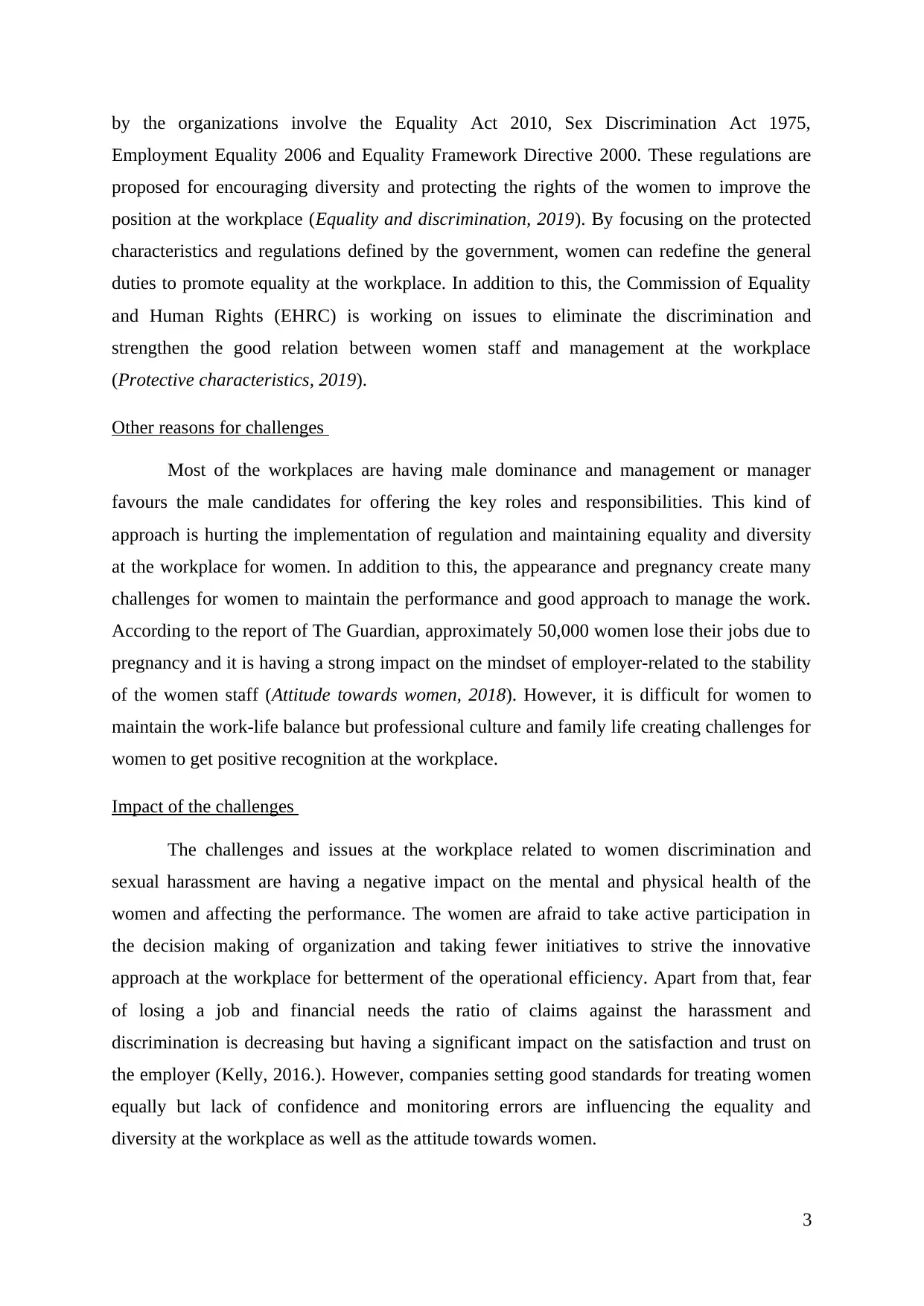
by the organizations involve the Equality Act 2010, Sex Discrimination Act 1975,
Employment Equality 2006 and Equality Framework Directive 2000. These regulations are
proposed for encouraging diversity and protecting the rights of the women to improve the
position at the workplace (Equality and discrimination, 2019). By focusing on the protected
characteristics and regulations defined by the government, women can redefine the general
duties to promote equality at the workplace. In addition to this, the Commission of Equality
and Human Rights (EHRC) is working on issues to eliminate the discrimination and
strengthen the good relation between women staff and management at the workplace
(Protective characteristics, 2019).
Other reasons for challenges
Most of the workplaces are having male dominance and management or manager
favours the male candidates for offering the key roles and responsibilities. This kind of
approach is hurting the implementation of regulation and maintaining equality and diversity
at the workplace for women. In addition to this, the appearance and pregnancy create many
challenges for women to maintain the performance and good approach to manage the work.
According to the report of The Guardian, approximately 50,000 women lose their jobs due to
pregnancy and it is having a strong impact on the mindset of employer-related to the stability
of the women staff (Attitude towards women, 2018). However, it is difficult for women to
maintain the work-life balance but professional culture and family life creating challenges for
women to get positive recognition at the workplace.
Impact of the challenges
The challenges and issues at the workplace related to women discrimination and
sexual harassment are having a negative impact on the mental and physical health of the
women and affecting the performance. The women are afraid to take active participation in
the decision making of organization and taking fewer initiatives to strive the innovative
approach at the workplace for betterment of the operational efficiency. Apart from that, fear
of losing a job and financial needs the ratio of claims against the harassment and
discrimination is decreasing but having a significant impact on the satisfaction and trust on
the employer (Kelly, 2016.). However, companies setting good standards for treating women
equally but lack of confidence and monitoring errors are influencing the equality and
diversity at the workplace as well as the attitude towards women.
3
Employment Equality 2006 and Equality Framework Directive 2000. These regulations are
proposed for encouraging diversity and protecting the rights of the women to improve the
position at the workplace (Equality and discrimination, 2019). By focusing on the protected
characteristics and regulations defined by the government, women can redefine the general
duties to promote equality at the workplace. In addition to this, the Commission of Equality
and Human Rights (EHRC) is working on issues to eliminate the discrimination and
strengthen the good relation between women staff and management at the workplace
(Protective characteristics, 2019).
Other reasons for challenges
Most of the workplaces are having male dominance and management or manager
favours the male candidates for offering the key roles and responsibilities. This kind of
approach is hurting the implementation of regulation and maintaining equality and diversity
at the workplace for women. In addition to this, the appearance and pregnancy create many
challenges for women to maintain the performance and good approach to manage the work.
According to the report of The Guardian, approximately 50,000 women lose their jobs due to
pregnancy and it is having a strong impact on the mindset of employer-related to the stability
of the women staff (Attitude towards women, 2018). However, it is difficult for women to
maintain the work-life balance but professional culture and family life creating challenges for
women to get positive recognition at the workplace.
Impact of the challenges
The challenges and issues at the workplace related to women discrimination and
sexual harassment are having a negative impact on the mental and physical health of the
women and affecting the performance. The women are afraid to take active participation in
the decision making of organization and taking fewer initiatives to strive the innovative
approach at the workplace for betterment of the operational efficiency. Apart from that, fear
of losing a job and financial needs the ratio of claims against the harassment and
discrimination is decreasing but having a significant impact on the satisfaction and trust on
the employer (Kelly, 2016.). However, companies setting good standards for treating women
equally but lack of confidence and monitoring errors are influencing the equality and
diversity at the workplace as well as the attitude towards women.
3
⊘ This is a preview!⊘
Do you want full access?
Subscribe today to unlock all pages.

Trusted by 1+ million students worldwide

PART B: EDUCATIONAL TOOLKIT
Gender inequality is having a significant impact on the participation of women in the
mainstream working approach of organizations. There are opportunities for women to lead
the organization and take initiatives for betterment but lack of awareness related to issues and
challenges as well the social construct is affecting the empowerment approach. Many factors
contribute to gender discrimination such as location, age, the composition of family and
personality that influence equality and diversity. Now, it is essential to improve the attitude
towards women and take strong actions against unconscious bias (Wing‐Fai, Gill, and
Randle, 2015). Despite it, the consideration of stereotypes is also important to develop
educational toolkit or employee manual to create awareness to overcome the harassment and
discrimination of women at the workplace. The major stereotype considered for gender
qualities involves the assertiveness, competitiveness, independence, courageousness and
masterful in achieving the goals.
Reason for using this format
The toolkit aims to create awareness and offering the information to the managers
related to the gender biasness and overcome the impact of the challenges to increase the
adaptability of staff members for regulations and equality rules of the government. The
employee manual or the toolkit will involve different types of indicator and knowledge
related to discrimination and harassment laws to aware the staff about gender equality and
women empowerment (Thébaud, 2015). The toolkit will involve data related to current
evidence and sustainable development approach of the company to minimize the issues of
sexual harassment, discrimination of women in salary, promotion and offering of the
responsibilities. Moreover, the toolkit is necessary for capacity building and encouraging the
women to protect their rights and work as an actor of change. Moreover, the proposed toolkit
is required to increase the general sensitivity and facilitate the idea of increasing mutual
understanding to promote societal changes (Ozturk, and Tatli, 2016).
Toolkit for creating awareness
The toolkit will involve the following indicators for creating awareness:
Valid: Measuring the effectiveness of issues at the workplace related to women.
Specific: Measure the particular aspect of organizational misconduct and policies for
women empowerment.
4
Gender inequality is having a significant impact on the participation of women in the
mainstream working approach of organizations. There are opportunities for women to lead
the organization and take initiatives for betterment but lack of awareness related to issues and
challenges as well the social construct is affecting the empowerment approach. Many factors
contribute to gender discrimination such as location, age, the composition of family and
personality that influence equality and diversity. Now, it is essential to improve the attitude
towards women and take strong actions against unconscious bias (Wing‐Fai, Gill, and
Randle, 2015). Despite it, the consideration of stereotypes is also important to develop
educational toolkit or employee manual to create awareness to overcome the harassment and
discrimination of women at the workplace. The major stereotype considered for gender
qualities involves the assertiveness, competitiveness, independence, courageousness and
masterful in achieving the goals.
Reason for using this format
The toolkit aims to create awareness and offering the information to the managers
related to the gender biasness and overcome the impact of the challenges to increase the
adaptability of staff members for regulations and equality rules of the government. The
employee manual or the toolkit will involve different types of indicator and knowledge
related to discrimination and harassment laws to aware the staff about gender equality and
women empowerment (Thébaud, 2015). The toolkit will involve data related to current
evidence and sustainable development approach of the company to minimize the issues of
sexual harassment, discrimination of women in salary, promotion and offering of the
responsibilities. Moreover, the toolkit is necessary for capacity building and encouraging the
women to protect their rights and work as an actor of change. Moreover, the proposed toolkit
is required to increase the general sensitivity and facilitate the idea of increasing mutual
understanding to promote societal changes (Ozturk, and Tatli, 2016).
Toolkit for creating awareness
The toolkit will involve the following indicators for creating awareness:
Valid: Measuring the effectiveness of issues at the workplace related to women.
Specific: Measure the particular aspect of organizational misconduct and policies for
women empowerment.
4
Paraphrase This Document
Need a fresh take? Get an instant paraphrase of this document with our AI Paraphraser
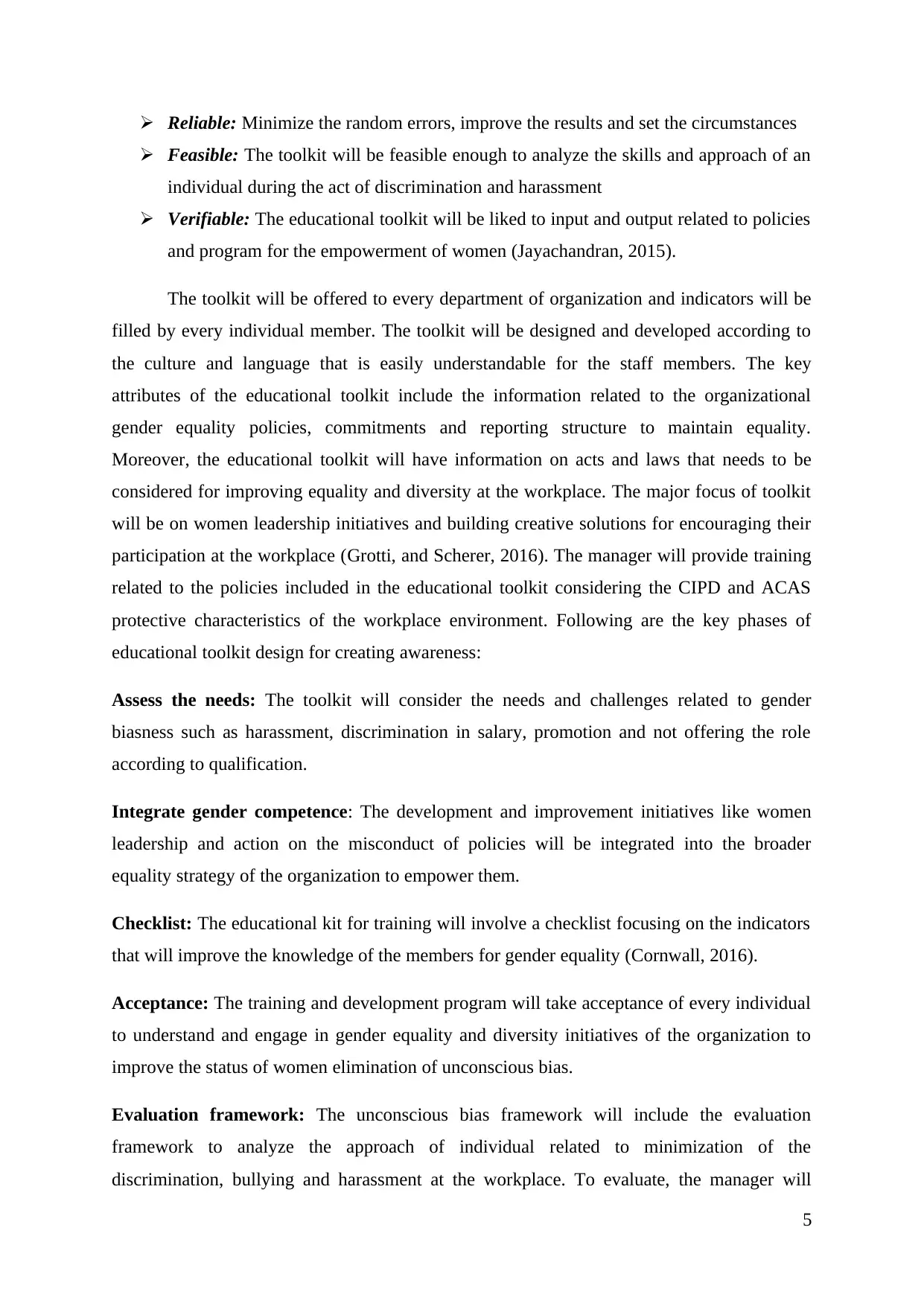
Reliable: Minimize the random errors, improve the results and set the circumstances
Feasible: The toolkit will be feasible enough to analyze the skills and approach of an
individual during the act of discrimination and harassment
Verifiable: The educational toolkit will be liked to input and output related to policies
and program for the empowerment of women (Jayachandran, 2015).
The toolkit will be offered to every department of organization and indicators will be
filled by every individual member. The toolkit will be designed and developed according to
the culture and language that is easily understandable for the staff members. The key
attributes of the educational toolkit include the information related to the organizational
gender equality policies, commitments and reporting structure to maintain equality.
Moreover, the educational toolkit will have information on acts and laws that needs to be
considered for improving equality and diversity at the workplace. The major focus of toolkit
will be on women leadership initiatives and building creative solutions for encouraging their
participation at the workplace (Grotti, and Scherer, 2016). The manager will provide training
related to the policies included in the educational toolkit considering the CIPD and ACAS
protective characteristics of the workplace environment. Following are the key phases of
educational toolkit design for creating awareness:
Assess the needs: The toolkit will consider the needs and challenges related to gender
biasness such as harassment, discrimination in salary, promotion and not offering the role
according to qualification.
Integrate gender competence: The development and improvement initiatives like women
leadership and action on the misconduct of policies will be integrated into the broader
equality strategy of the organization to empower them.
Checklist: The educational kit for training will involve a checklist focusing on the indicators
that will improve the knowledge of the members for gender equality (Cornwall, 2016).
Acceptance: The training and development program will take acceptance of every individual
to understand and engage in gender equality and diversity initiatives of the organization to
improve the status of women elimination of unconscious bias.
Evaluation framework: The unconscious bias framework will include the evaluation
framework to analyze the approach of individual related to minimization of the
discrimination, bullying and harassment at the workplace. To evaluate, the manager will
5
Feasible: The toolkit will be feasible enough to analyze the skills and approach of an
individual during the act of discrimination and harassment
Verifiable: The educational toolkit will be liked to input and output related to policies
and program for the empowerment of women (Jayachandran, 2015).
The toolkit will be offered to every department of organization and indicators will be
filled by every individual member. The toolkit will be designed and developed according to
the culture and language that is easily understandable for the staff members. The key
attributes of the educational toolkit include the information related to the organizational
gender equality policies, commitments and reporting structure to maintain equality.
Moreover, the educational toolkit will have information on acts and laws that needs to be
considered for improving equality and diversity at the workplace. The major focus of toolkit
will be on women leadership initiatives and building creative solutions for encouraging their
participation at the workplace (Grotti, and Scherer, 2016). The manager will provide training
related to the policies included in the educational toolkit considering the CIPD and ACAS
protective characteristics of the workplace environment. Following are the key phases of
educational toolkit design for creating awareness:
Assess the needs: The toolkit will consider the needs and challenges related to gender
biasness such as harassment, discrimination in salary, promotion and not offering the role
according to qualification.
Integrate gender competence: The development and improvement initiatives like women
leadership and action on the misconduct of policies will be integrated into the broader
equality strategy of the organization to empower them.
Checklist: The educational kit for training will involve a checklist focusing on the indicators
that will improve the knowledge of the members for gender equality (Cornwall, 2016).
Acceptance: The training and development program will take acceptance of every individual
to understand and engage in gender equality and diversity initiatives of the organization to
improve the status of women elimination of unconscious bias.
Evaluation framework: The unconscious bias framework will include the evaluation
framework to analyze the approach of individual related to minimization of the
discrimination, bullying and harassment at the workplace. To evaluate, the manager will
5
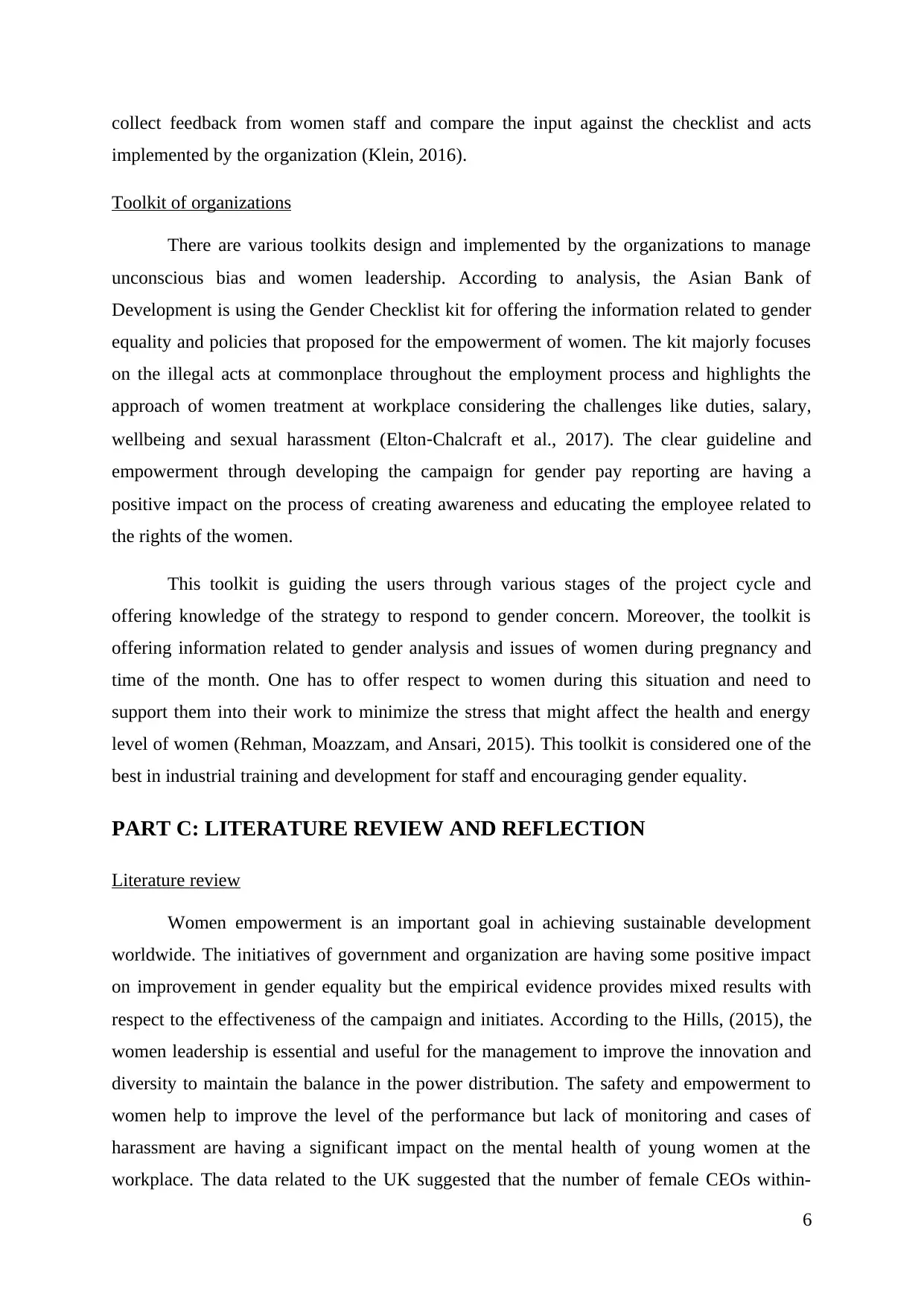
collect feedback from women staff and compare the input against the checklist and acts
implemented by the organization (Klein, 2016).
Toolkit of organizations
There are various toolkits design and implemented by the organizations to manage
unconscious bias and women leadership. According to analysis, the Asian Bank of
Development is using the Gender Checklist kit for offering the information related to gender
equality and policies that proposed for the empowerment of women. The kit majorly focuses
on the illegal acts at commonplace throughout the employment process and highlights the
approach of women treatment at workplace considering the challenges like duties, salary,
wellbeing and sexual harassment (Elton‐Chalcraft et al., 2017). The clear guideline and
empowerment through developing the campaign for gender pay reporting are having a
positive impact on the process of creating awareness and educating the employee related to
the rights of the women.
This toolkit is guiding the users through various stages of the project cycle and
offering knowledge of the strategy to respond to gender concern. Moreover, the toolkit is
offering information related to gender analysis and issues of women during pregnancy and
time of the month. One has to offer respect to women during this situation and need to
support them into their work to minimize the stress that might affect the health and energy
level of women (Rehman, Moazzam, and Ansari, 2015). This toolkit is considered one of the
best in industrial training and development for staff and encouraging gender equality.
PART C: LITERATURE REVIEW AND REFLECTION
Literature review
Women empowerment is an important goal in achieving sustainable development
worldwide. The initiatives of government and organization are having some positive impact
on improvement in gender equality but the empirical evidence provides mixed results with
respect to the effectiveness of the campaign and initiates. According to the Hills, (2015), the
women leadership is essential and useful for the management to improve the innovation and
diversity to maintain the balance in the power distribution. The safety and empowerment to
women help to improve the level of the performance but lack of monitoring and cases of
harassment are having a significant impact on the mental health of young women at the
workplace. The data related to the UK suggested that the number of female CEOs within-
6
implemented by the organization (Klein, 2016).
Toolkit of organizations
There are various toolkits design and implemented by the organizations to manage
unconscious bias and women leadership. According to analysis, the Asian Bank of
Development is using the Gender Checklist kit for offering the information related to gender
equality and policies that proposed for the empowerment of women. The kit majorly focuses
on the illegal acts at commonplace throughout the employment process and highlights the
approach of women treatment at workplace considering the challenges like duties, salary,
wellbeing and sexual harassment (Elton‐Chalcraft et al., 2017). The clear guideline and
empowerment through developing the campaign for gender pay reporting are having a
positive impact on the process of creating awareness and educating the employee related to
the rights of the women.
This toolkit is guiding the users through various stages of the project cycle and
offering knowledge of the strategy to respond to gender concern. Moreover, the toolkit is
offering information related to gender analysis and issues of women during pregnancy and
time of the month. One has to offer respect to women during this situation and need to
support them into their work to minimize the stress that might affect the health and energy
level of women (Rehman, Moazzam, and Ansari, 2015). This toolkit is considered one of the
best in industrial training and development for staff and encouraging gender equality.
PART C: LITERATURE REVIEW AND REFLECTION
Literature review
Women empowerment is an important goal in achieving sustainable development
worldwide. The initiatives of government and organization are having some positive impact
on improvement in gender equality but the empirical evidence provides mixed results with
respect to the effectiveness of the campaign and initiates. According to the Hills, (2015), the
women leadership is essential and useful for the management to improve the innovation and
diversity to maintain the balance in the power distribution. The safety and empowerment to
women help to improve the level of the performance but lack of monitoring and cases of
harassment are having a significant impact on the mental health of young women at the
workplace. The data related to the UK suggested that the number of female CEOs within-
6
⊘ This is a preview!⊘
Do you want full access?
Subscribe today to unlock all pages.

Trusted by 1+ million students worldwide

country was only 7 by June 2018 and proportion of women in UK House of Commons was
37% as well as the proportion of women police in-country is 21.7%. This gap shows that
there is a lack of equality and diversity at the workplace for women (Sharma, 2016).
Therefore, concentrated efforts are needed from the government and employers to empower
the women and promote the leadership at the workplace by changing the attitude towards the
women.
According to the theory of the Teflon effect, the alignment between occupational
bodies and social bodies is essential for minimizing gender inequality and maintaining the
perceived characteristics proposed in the CIPD and ACAS. The theory has made emphasis on
barriers and challenges faced by the women to undertake the leadership position at the
workplace. The Teflon effect has been discussed by focusing on the glass ceiling and glass
slipper to maintain the systematic forms of advantage and disadvantage. There is a need for
changes in the attitude of the people to minimize the discrimination and empowering the
women. However, the secondary data analysis suggests the different picture of initiatives
(Simpson, and Kumra, 2016). 48% of women are facing the issue of discrimination in the
workplace due to wages and promotion. The numbers of this type of discrimination could be
high but to maintain the job women are not raising the voice against it. In addition to this,
29% of women have faced sexual harassment at the workplace during 2015-2019 which is
higher in the last 10 years.
Reflection
Contradict of views:
The review of literature and data collected from the sources is having differences as
the issues related to discrimination and harassment of women at workplace is increasing. The
views presented by different authors and reports are an eye-opener for industry and
management to understand the gap between the approach of empowerment and actual results.
The analysis of both theory and data is having many contradicts which create doubt on the
managers and employers to implement the policies and maintain equality at the workplace to
improve the diversity. There are many toolkits and approaches are available but lack of a
positive attitude towards the women and fewer efforts at the ground are influencing the
results. To improve the situation and results, the organizations must provide free space for
women and young girls to work freely and share the ideas.
7
37% as well as the proportion of women police in-country is 21.7%. This gap shows that
there is a lack of equality and diversity at the workplace for women (Sharma, 2016).
Therefore, concentrated efforts are needed from the government and employers to empower
the women and promote the leadership at the workplace by changing the attitude towards the
women.
According to the theory of the Teflon effect, the alignment between occupational
bodies and social bodies is essential for minimizing gender inequality and maintaining the
perceived characteristics proposed in the CIPD and ACAS. The theory has made emphasis on
barriers and challenges faced by the women to undertake the leadership position at the
workplace. The Teflon effect has been discussed by focusing on the glass ceiling and glass
slipper to maintain the systematic forms of advantage and disadvantage. There is a need for
changes in the attitude of the people to minimize the discrimination and empowering the
women. However, the secondary data analysis suggests the different picture of initiatives
(Simpson, and Kumra, 2016). 48% of women are facing the issue of discrimination in the
workplace due to wages and promotion. The numbers of this type of discrimination could be
high but to maintain the job women are not raising the voice against it. In addition to this,
29% of women have faced sexual harassment at the workplace during 2015-2019 which is
higher in the last 10 years.
Reflection
Contradict of views:
The review of literature and data collected from the sources is having differences as
the issues related to discrimination and harassment of women at workplace is increasing. The
views presented by different authors and reports are an eye-opener for industry and
management to understand the gap between the approach of empowerment and actual results.
The analysis of both theory and data is having many contradicts which create doubt on the
managers and employers to implement the policies and maintain equality at the workplace to
improve the diversity. There are many toolkits and approaches are available but lack of a
positive attitude towards the women and fewer efforts at the ground are influencing the
results. To improve the situation and results, the organizations must provide free space for
women and young girls to work freely and share the ideas.
7
Paraphrase This Document
Need a fresh take? Get an instant paraphrase of this document with our AI Paraphraser

The connection between theories and data:
According to the evaluation and results of the study, there is a lack of connection
between theory and data of the women leadership and empowerment. There is no
improvement in the rate of the leadership of women from the last five years. The involvement
of women in the industrial process is less and hurting the equality and diversity management
campaign and initiatives of the government and organizations in the UK and across the globe.
However, the Teflon effect highlighted the significance of recognizing women power and
allowing them into the management leadership role.
Importance of minimizing unconscious bias:
There are numbers of claims related to harassment, discrimination, and victimization
as well as bullying at the workplace. However, there are many policies and protection
characteristics presented and implemented by the leading organizations to overcome the
issues but biasness at the workplace is affecting the effectiveness of women. According to
analysis, women are taking active participation in the workplace from 30 years and earning
more bachelor degrees than man but there are less salary and promotion offered to them at the
workplace. It is essential to empower them to improve balance and diversity in the
workplace.
Evaluation of toolkit:
The proposed toolkit for educating the employee is beneficial for organizations to
train the staff. The key attributes of the educational toolkit include the information related to
the organizational gender equality policies, commitments and reporting structure to maintain
the equality (Equality and discrimination, 2019). Moreover, the educational toolkit will have
information on acts and laws that needs to be considered for improving equality and diversity
at the workplace.
Recommendations:
To improve the situation and attitude towards the women at the workplace, it is
essential to understand the needs and challenges for the women and professional activities
that required to be considered for managing the quality environment. To craft long term
improvement, it is recommended to improve the participation of women staff in decision
making and offer the leading position to encourage the level of trust. The strong actions on
8
According to the evaluation and results of the study, there is a lack of connection
between theory and data of the women leadership and empowerment. There is no
improvement in the rate of the leadership of women from the last five years. The involvement
of women in the industrial process is less and hurting the equality and diversity management
campaign and initiatives of the government and organizations in the UK and across the globe.
However, the Teflon effect highlighted the significance of recognizing women power and
allowing them into the management leadership role.
Importance of minimizing unconscious bias:
There are numbers of claims related to harassment, discrimination, and victimization
as well as bullying at the workplace. However, there are many policies and protection
characteristics presented and implemented by the leading organizations to overcome the
issues but biasness at the workplace is affecting the effectiveness of women. According to
analysis, women are taking active participation in the workplace from 30 years and earning
more bachelor degrees than man but there are less salary and promotion offered to them at the
workplace. It is essential to empower them to improve balance and diversity in the
workplace.
Evaluation of toolkit:
The proposed toolkit for educating the employee is beneficial for organizations to
train the staff. The key attributes of the educational toolkit include the information related to
the organizational gender equality policies, commitments and reporting structure to maintain
the equality (Equality and discrimination, 2019). Moreover, the educational toolkit will have
information on acts and laws that needs to be considered for improving equality and diversity
at the workplace.
Recommendations:
To improve the situation and attitude towards the women at the workplace, it is
essential to understand the needs and challenges for the women and professional activities
that required to be considered for managing the quality environment. To craft long term
improvement, it is recommended to improve the participation of women staff in decision
making and offer the leading position to encourage the level of trust. The strong actions on
8
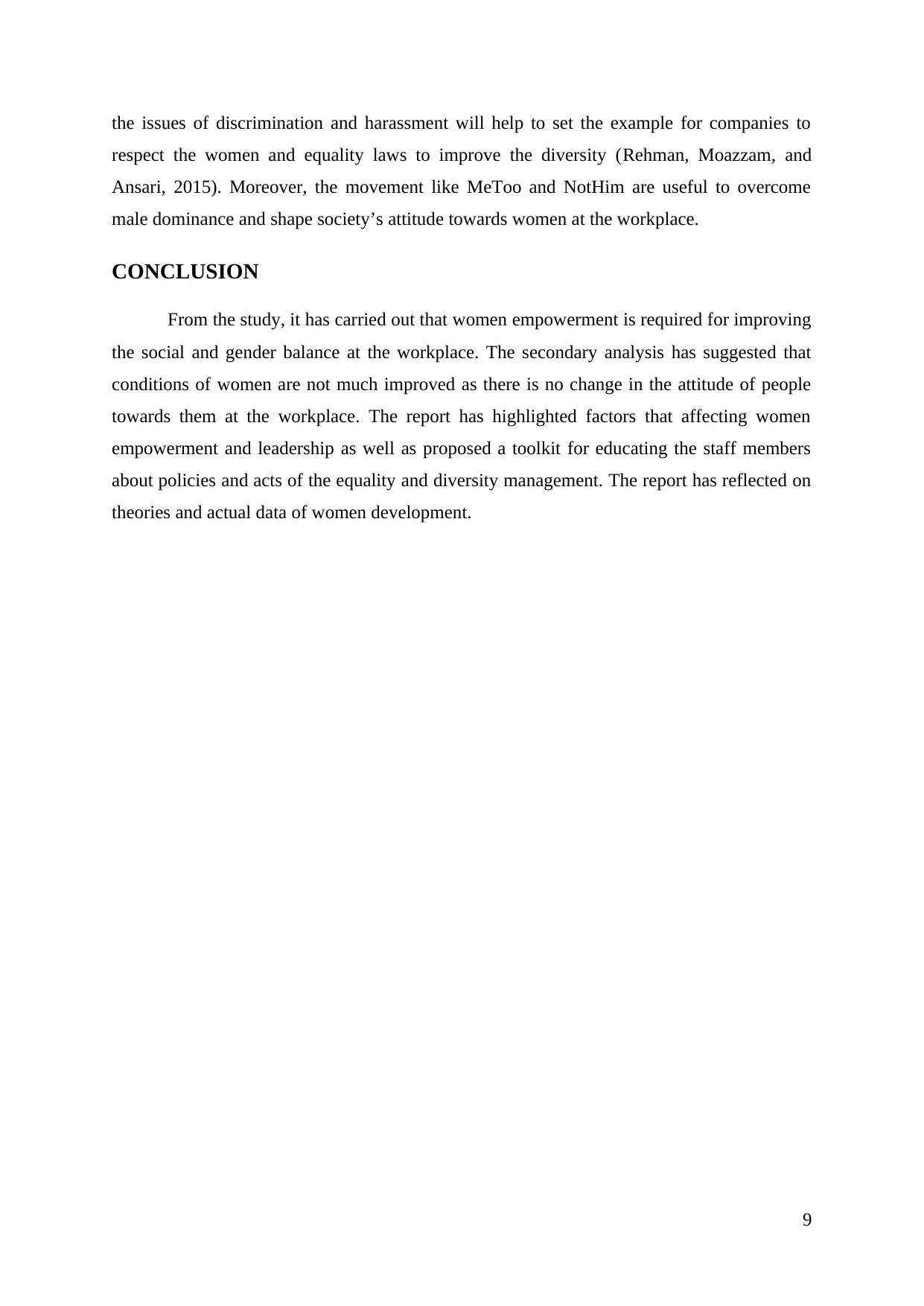
the issues of discrimination and harassment will help to set the example for companies to
respect the women and equality laws to improve the diversity (Rehman, Moazzam, and
Ansari, 2015). Moreover, the movement like MeToo and NotHim are useful to overcome
male dominance and shape society’s attitude towards women at the workplace.
CONCLUSION
From the study, it has carried out that women empowerment is required for improving
the social and gender balance at the workplace. The secondary analysis has suggested that
conditions of women are not much improved as there is no change in the attitude of people
towards them at the workplace. The report has highlighted factors that affecting women
empowerment and leadership as well as proposed a toolkit for educating the staff members
about policies and acts of the equality and diversity management. The report has reflected on
theories and actual data of women development.
9
respect the women and equality laws to improve the diversity (Rehman, Moazzam, and
Ansari, 2015). Moreover, the movement like MeToo and NotHim are useful to overcome
male dominance and shape society’s attitude towards women at the workplace.
CONCLUSION
From the study, it has carried out that women empowerment is required for improving
the social and gender balance at the workplace. The secondary analysis has suggested that
conditions of women are not much improved as there is no change in the attitude of people
towards them at the workplace. The report has highlighted factors that affecting women
empowerment and leadership as well as proposed a toolkit for educating the staff members
about policies and acts of the equality and diversity management. The report has reflected on
theories and actual data of women development.
9
⊘ This is a preview!⊘
Do you want full access?
Subscribe today to unlock all pages.

Trusted by 1+ million students worldwide
1 out of 18
Related Documents
Your All-in-One AI-Powered Toolkit for Academic Success.
+13062052269
info@desklib.com
Available 24*7 on WhatsApp / Email
![[object Object]](/_next/static/media/star-bottom.7253800d.svg)
Unlock your academic potential
Copyright © 2020–2025 A2Z Services. All Rights Reserved. Developed and managed by ZUCOL.





